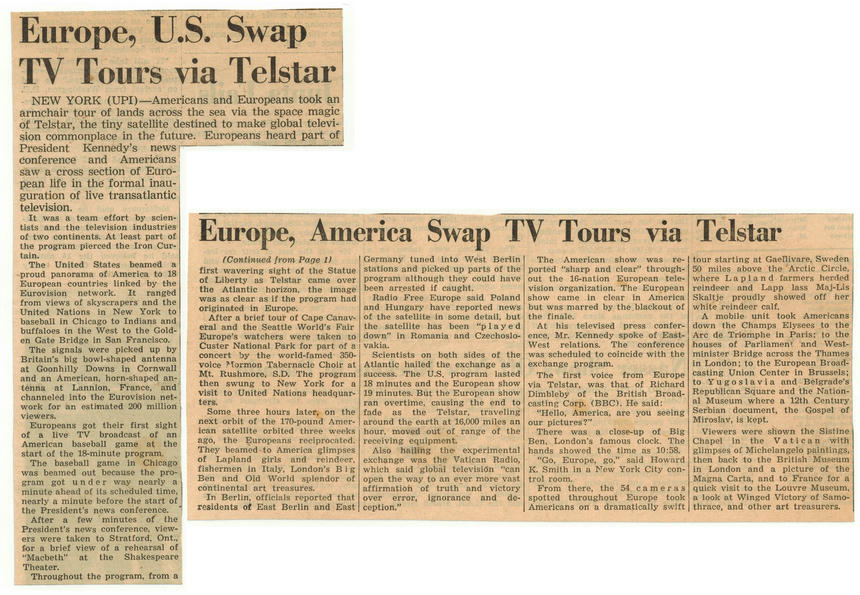Scrapbook 3: Europe, U.S. Swap TV Tours via Telstar, Europe, America Swap TV Tours via Telstar

Europe, U.S. Swap TV Tours via Telstar
NEW YORK (UPI)—Americans and Europeans took an armchair tour of lands across the sea via the space magic of Telstar, the tiny satellite destined to make global television commonplace in the future. Europeans heard part of President Kennedy’s news conference and Americans saw a cross section of European life in the formal inauguration of live transatlantic television.
It was a team effort by scientists and the television industries of two continents. At least part of the program pierced the Iron Curtain.
The United States beamed a proud panorama of America to 18 European countries linked by the Eurovision network. It ranged from views of skyscrapers and the United Nations in New York to baseball in Chicago to Indians and buffaloes in the West to the Golden Gate Bridge in San Francisco.
The signals were picked up by Britain’s big bowl-shaped antenna at Goonhilly Downs in Cornwall and an American, horn-shaped antenna at Lannion, France, and channeled into the Eurovision network for an estimated 200 million viewers.
Europeans got their first sight of a live TV broadcast of an American baseball game at the start of the 18-minute program.
The baseball game in Chicago was beamed out because the program got under way nearly a minute ahead of its scheduled time, nearly a minute before the start of the President’s news conference.
After a few minutes of the President’s news conference, viewers were taken to Stratford, Ont., for a brief view of a rehearsal of “Macbeth” at the Shakespeare Theater.
Throughout the program, from a
Europe, America Swap TV Tours via Telstar
(Continued from Page 1)
first wavering sight of the Statue of Liberty as Telstar came over the Atlantic horizon, the image was as clear as if the program had originated in Europe.
After a brief tour of Cape Canaveral and the Seattle World’s Fair Europe’s watchers were taken to Custer National Park for part of a concert by the world-famed 350-voice Mormon Tabernacle Choir at Mt. Rushmore, S.D. The program then swung to New York for a visit to United Nations headquarters.
Some three hours later, on the next orbit of the 170-pound American satellite orbited three weeks ago, the Europeans reciprocated. They beamed to America glimpses of Lapland girls and reindeer, fishermen in Italy, London’s Big Ben and Old World splendor of continental art treasures.
In Berlin, officials reported that residents of East Berlin and East Germany tuned into West Berlin stations and picked up parts of the program although they could have been arrested if caught.
Radio Free Europe said Poland and Hungary have reported news of the satellite in some detail, but the satellite has been “played down” in Romania and Czechoslovakia.
Scientists on both sides of the Atlantic hailed the exchange as a success. The U.S. program lasted 18 minutes and the European show 19 minutes. But the European show ran overtime, causing the end to fade as the Telstar, traveling around the earth at 16,000 miles an hour, moved out of range of the receiving equipment.
Also hailing the experimental exchange was the Vatican Radio, which said global television “can open the way to an ever more vast affirmation of truth and victory over error, ignorance and deception.”
The American show was reported “sharp and clear” throughout the 16-nation European television organization. The European show came in clear in America but was marred by the blackout of the finale.
At his televised press conference, Mr. Kennedy spoke of East-West relations. The conference was scheduled to coincide with the exchange program.
The first voice from Europe via Telstar, was that of Richard Dimbleby of the British Broadcasting Corp. (BBC). He said:
“Hello, America, are you seeing our pictures?”
There was a close-up of Big Ben, London’s famous clock. The hands showed the time as 10:58.
“Go, Europe, go,” said Howard K. Smith in a New York City control room.
From there, the 54 cameras spotted throughout Europe took Americans on a dramatically swift tour starting at Gaellivare, Sweden 50 miles above the Arctic Circle, where Lapland farmers herded reindeer and Lapp lass Maj-Lis Skaltje proudly showed off her white reindeer calf.
A mobile unit took Americans down the Champs Elysees to the Arc de Triomphe in Paris; to the houses of Parliament and Westminister Bridge across the Thames in London; to the European Broadcasting Union Center in Brussels; to Yugoslavia and Belgrade’s Republican Square and the National Museum where a 12th Century Serbian document, the Gospel of Miroslav, is kept.
Viewers were shown the Sistine Chapel in the Vatican with glimpses of Michelangelo paintings, then back to the British Museum in London and a picture of the Magna Carta, and to France for a quick visit to the Louvre Museum, a look at Winged Victory of Samothrace, and other art treasurers.